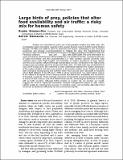Por favor, use este identificador para citar o enlazar a este item:
http://hdl.handle.net/10261/177182COMPARTIR / EXPORTAR:
 SHARE
BASE SHARE
BASE
|
|
| Visualizar otros formatos: MARC | Dublin Core | RDF | ORE | MODS | METS | DIDL | DATACITE | |

| Título: | Large birds of prey, policies that alter food availability and air traffic: a risky mix for human safety |
Autor: | Moreno-Opo, Rubén; Margalida, Antoni CSIC ORCID | Palabras clave: | Aegypius monachus Airport management Bird strike Cinereous vulture Food availability Griff on vulture Gyps fulvus Raptors Risk assessment Sanitary policies Spain |
Fecha de publicación: | 2017 | Editor: | Berryman Institute | Citación: | Human–Wildlife Interactions 11(3): 339–350 (2017) | Resumen: | Raptors are considered to pose one of the greatest aviation bird strike risks. We investigated raptor bird strikes reported at the largest Spanish airport (Adolfo Suárez Madrid Barajas; AS-MB) from 2009 to 2016 to determine the factors contributing to the increased incidences and develop recommendations to mitigate the risks. We hypothesized that increased raptor bird strikes resulted from changes in foraging and dispersal patterns of Iberian Peninsula vultures (Aegypius spp. and Gyps spp.) after 2004–2005. We used information on raptor bird strikes obtained from official databases and published studies, reported incidences of raptor bird strikes and their characteristics (i.e., time, location, species involved), data collected about raptor fl ight heights, and estimates of relative abundance of large raptors and their prey species obtained through standardized surveys conducted in the high priority aviation area around the airport to assess bird strike risks. Our fi eld work was conducted from June 2014 to May 2016. We confi rmed a direct relationship between the relative abundance of the raptors studied and their prey species in the priority aviation areas. Raptor bird strike risks increased during spring and summer when food sources were abundant in locations where fl ight altitudes of aircraft were <1000 m above ground level. Our observations appear to be related to European Union sanitary policies that altered the availability and occurrence of livestock carcasses. These changes may have increased the overall movement of vultures in search of new, scarcer, and more distant food sources, enhancing the likelihood of overlap with air traffic corridors. Although further studies on aviation risk are needed, our results suggest the need to implement immediate remedial management actions to alter vulture habitat quality by reducing food sources in sensitive areas, and providing alternative food resources at distances suffi ciently far from commercial airports. | Versión del editor: | https://doi.org/10.26077/2cxm-ge37 | URI: | http://hdl.handle.net/10261/177182 | ISSN: | 2155-3858 | E-ISSN: | 2155-3874 |
| Aparece en las colecciones: | (IREC) Artículos |
Ficheros en este ítem:
| Fichero | Descripción | Tamaño | Formato | |
|---|---|---|---|---|
| largesafety.pdf | 465,72 kB | Adobe PDF |  Visualizar/Abrir |
CORE Recommender
Page view(s)
251
checked on 19-abr-2024
Download(s)
117
checked on 19-abr-2024
Google ScholarTM
Check
Este item está licenciado bajo una Licencia Creative Commons

